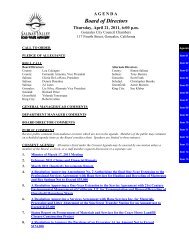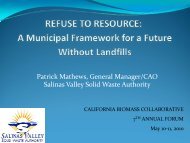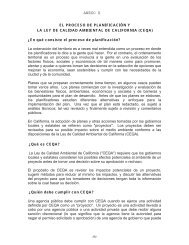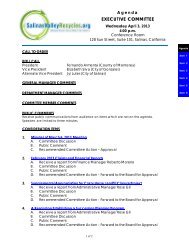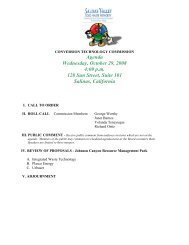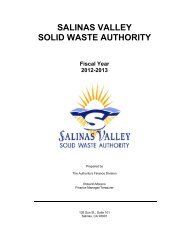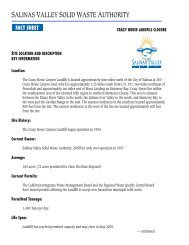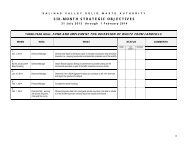revised final closure plan - Salinas Valley Solid Waste Authority
revised final closure plan - Salinas Valley Solid Waste Authority
revised final closure plan - Salinas Valley Solid Waste Authority
Create successful ePaper yourself
Turn your PDF publications into a flip-book with our unique Google optimized e-Paper software.
Revised Final Closure Plan July 2010<br />
Crazy Horse Sanitary Landfill -25- 103-97133<br />
Leachate Recirculation - The proposed method for leachate and LFG condensate management at the<br />
closed CHLF is recirculation. The storage tanks discussed above would still be available as a backup<br />
management system. The location of the proposed recirculation gallery is shown on Figures 4 and 6.<br />
Leachate recirculation at the CHLF has been analyzed according to the regulatory and operational<br />
restrictions presented in Appendix D1 of this report. That analysis determined that a properly design<br />
and constructed recirculation system will achieve the following:<br />
• Operate within a Title 27 and Subtitle D compliant base liner and operating<br />
LCRS system.<br />
• The recirculation system should not generate leachate seeps thereby discharging<br />
contaminants to surface run-off. Trenches will be located at least 85 feet from<br />
the slope face.<br />
• The recirculation system is not expected to cause instability in the waste.<br />
• The recirculation system is not expected to generate landfill gas beyond the<br />
extraction capacity of the active landfill gas extraction system at the site.<br />
• Recirculation will be limited so that it does not generate leachate volumes in<br />
exceedance of the hydraulic capacity of the LCRS.<br />
Furthermore, the proposed recirculation system is compatible with the Class III liner systems at the<br />
CHLF and will not harm public health or the environment.<br />
Based on the evaluations presented in Appendix D1, the following design criteria are recommended<br />
for leachate and LFG condensate recirculation at the CHLF:<br />
• Locate recirculation trenches a minimum of 85-feet from any slope face.<br />
• Trenches shall be placed towards the downslope end of the topdeck to<br />
accommodate surface water drainage with accelerated differential settlement in<br />
the recirculation area.<br />
• The maximum application rate should be no more than 6,100 gpd or 35 gpd/ft for<br />
the proposed 174-foot horizontal trench.<br />
• The trench should have a total depth of at least 5 feet with shredded tire particles<br />
at least 2 feet thick and 3 feet wide. They should also be preferentially level to<br />
evenly distribute liquids. The tire particles shall be covered with 3 feet of<br />
compacted soil.<br />
Leachate generation should decrease during the post<strong>closure</strong> period as the <strong>final</strong> cover system will<br />
significantly reduce rainfall infiltration and the waste mass stabilizes. The Environmental Protection<br />
Agency (EPA) evaluated containment performance for numerous landfills throughout the United<br />
States (EPA, 2002) and found that following landfill <strong>closure</strong> with a low-permeability cover, leachate<br />
generation rates typically decrease by 90 percent within the first 2 to 4 years and then decrease to near<br />
zero within 10 years. The National Research Council (NRC) reported leachate generation decreases<br />
to 1 percent of the annual precipitation 10 years after <strong>closure</strong> with a composite <strong>final</strong> cover (NRC,<br />
2007).<br />
Golder Associates



